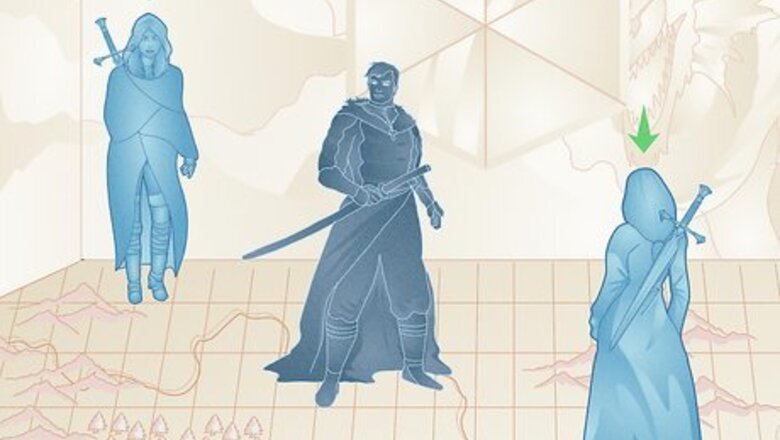
views
- Flanking is a tactical maneuver in D&D 5e. “Flanking” an enemy means positioning two or more allies within 5 feet of them on opposite sides.
- When an enemy is flanked, you have advantage on attack rolls against them, meaning you can roll a d20 twice and take the higher result.
- Counter flanking by disengaging from enemies, or by using a spell or class feature to get away without provoking an attack of opportunity.
Flanking in D&D 5e: Overview

Flanking is an optional rule that grants a strategic advantage in battle. According to the 5e rulebook, “flanking” is a tactical maneuver that involves positioning two allies within 5 feet of an enemy on opposite sides. When two allies are on opposite sides or corners of an enemy's space, they gain advantage on all melee attack rolls against the enemy. Advantage means rolling 2d20s (instead of one) and taking the higher result, making your attack more likely to hit. Remember: ranged PCs (who attack from a distance) can’t flank because they’re not within 5 feet of enemies. Since it’s an optional rule, flanking might not be included in your home game of D&D. DMs decide whether to enforce flanking. Some think it complicates combat too much, while others feel it adds strategy and intrigue.
Types of Flanking

Flanking with a grid Many people use gridded battle maps for battles. On maps with square and hexagonal grids, your PC is “flanking” when they’re next to an enemy and on the opposite side (or corner) of an enemy’s space from an ally. To double-check, draw a line through the center of each creature’s space to determine if an enemy is flanked. If the line you draw crosses through the opposite sides or corners of your enemy’s space, that enemy is effectively flanked. The number of hexes between allies on a hexagonal grid also determines the size of the creature they can flank. For example: Medium (or smaller) creatures: 2 hexes between allies Large creatures: 4 hexes between allies Huge creatures: 5 hexes between allies Gargantuan creatures: At least 6 hexes between allies

Theater of the mind flanking “Theater of the Mind” simply means you’re not using a battle map, miniatures, or any visual aids. If you’re a player, make sure to describe your intentions (and PC’s position) clearly. If you’re a DM, keep track of all relevant information because you have the final call on whether PCs are successfully flanking. Theater of the mind is more abstract than typical combat with a battle map, which is why it’s vital to stay on top of everything. For example, as a player, you might say, “I want to attack the vampire with my longsword from the opposite side that my ally is on.” If you’re a DM, it’s your job to remember where that PC moves so you can give them (and their ally) a flanking bonus.
How to Use Flanking

Flank enemies in any encounter where you and an ally are both able. There’s no limit to when or where flanking can be used—so if the DM allows it, take advantage of the flanking rule whenever possible! As long as you and an ally are following the rules correctly (and neither of you are incapacitated), you can get the flanking bonus. Keep in mind that if you’re a DM who allows the flanking rule, you can have monsters flank your players too. Tactically clever enemies (or creatures with a pack mentality) could attempt to flank a party’s heavy-hitting melee fighter or barbarian, for example.

Avoid provoking opportunity attacks when flanking enemies. When you leave an enemy’s reach, they can use a reaction to make an “opportunity attack” against your PC. Be mindful of this when moving into a flanking position to ensure you’re not putting your PC in a position where they might be attacked (and take extra damage).

Flank enemies with a high armor class to make them easier to hit. In 5e, a creature’s armor class (AC) determines how easy it is to hit them—and the higher the AC, the harder they are to hit. So, if an enemy has a high AC, try flanking them to get advantage on all your attacks (and possibly score extra hits against them).

Take the Sentinel feat to enhance your flanking abilities. The Sentinel feat lets you make an opportunity attack even if your enemy disengages—and stops enemies from moving if they get hit with an opportunity attack. Thus, the Sentinel feat can help you lock enemies into a position where you and an ally can flank and defeat them. The “grapple” action can also help you stop enemies from escaping a flanking position. By grappling an enemy, you’re basically holding onto them and pinning them in place until they can break the grapple!
How to Counter Flanking

Escape the flanker using a spell or class feature. If you can teleport or get out of melee range without taking an attack of opportunity, do it! Getting flanked is dangerous, so take stock of your spells and feats to see if you have an escape. If nothing else, consider using the disengage action, which lets you avoid provoking opportunity attacks while moving. For example: Misty Step is a level 2 spell that allows you to teleport 30 feet away as a bonus action. Cunning Action is a class feature for rogues, allowing them to disengage as a bonus action. Mobile is a feat—and with it, attacking enemies prevents them from getting opportunity attacks on you.

Take an opportunity attack and run away from the flanker. Sometimes, there’s no way to escape a flanked position without taking an attack of opportunity. However, if you play a “tank” PC (with heavy armor or lots of hit points), you might be able to withstand the attack—so use your best judgment and run away if you feel it’s the best move. Remember: creatures can only make a single opportunity attack per round. If you have a choice between taking one attack or several (when it comes to each enemy’s turn), it might be wisest to cut your losses and run.

Focus all your firepower on one of the flankers or incapacitate them. To stop enemies from flanking you, simply overpower and defeat one of them. Encourage your entire party (or as many as possible) to focus their attacks on one of the flankers—and, ideally, defeat them before they can take too many attacks on your PC. If you take out an enemy early, this can also leave the surviving one in a dangerous position (potentially surrounded by your party). You could also have a spellcaster use a spell such as Hold Person or Tasha’s Hideous Laughter to incapacitate a flanker.
Is flanking a good rule?

Flanking is very effective, especially with lots of melee characters. The more melee (close-range) PCs in your party, the more flanking options you have in battle. So, if your party has a lot of melee fighters, use the flanking rule often—it’ll make the party much more powerful and help you land successful hits, especially among large groups of enemies. Consider using the flanking rule when fighting larger creatures, too. The larger the creature, the more options you have to flank it. For example, while there are 4 ways to flank a medium-sized creature on a grid map, but 6 ways to flank a large creature. No matter how large or fearsome a creature is, it’s much easier to defeat when two or more party members have advantage against it!

Some DMs think flanking is too overpowered in 5e. Getting advantage on all melee attacks enables PCs to do huge amounts of damage (and makes combat significantly easier). Plus, enemies need to use an action to disengage or take 2 attacks of opportunity (one from each PC) to escape a flanking position. Thus, some DMs choose to ignore the flanking rule because they feel like it gives PCs too much strength. However, if you’re a DM, you could always modify the rule or homebrew your own! For example, you might use the 4th edition rules instead, which state that flanking grants a +2 to your attack bonus. That way, there’s still an incentive for players to think strategically, but they don’t get advantage on every hit!

Incorporating flanking into battles may slow them down. While this isn’t always true, some DMs find that players strategize for a long time during battles (even though, realistically, PCs shouldn't be able to stop and talk). Extra rules like flanking may delay players who want to use it to their best advantage. However, if you’re a DM, there’s a simple solution to this problem: put reasonable time limits on your players. For example, you might let them discuss for 1 minute or 30 seconds—but once that’s over, they have to act. Players deserve to be rewarded for working together, but it’s also important to keep combat running smoothly!

Flanking can be redundant because advantage doesn’t stack. Even if an enemy is flanked and affected by a condition that grants advantage against them, there’s no extra benefit for PCs—either they get advantage or they don’t. It may feel underwhelming if players do it but already have advantage from another effect. Flanking is also a risk. A melee-oriented PC might have to put themselves in danger to get into a flanking position. Say the party’s fighter takes a risk and flanks an enemy, only for the wizard to incapacitate them with Hold Person. Since Hold Person grants advantage on attacks against that enemy, the fighter might feel like they’re in danger for no reason.
Other Ways to Get Advantage on Enemies

Class features If you want advantage but you’re not in a position to flank an enemy, don’t worry—there are plenty of options. Most classes have some sort of feature or ability that’ll give them an edge on attack rolls or spell attacks, so take stock of your class features and pinpoint any that might help. For example: Reckless Attack gives barbarians advantage on attack rolls (though enemies also have advantage on their attacks). Totem Spirit (Wolf) gives allies advantage on attack rolls against creatures within melee range of the barbarian using the ability. Maneuvers (from the Battle Master fighter subclass) like Distracting Strike, Feinting Attack, and Trip Attack all grant advantage on melee attacks.

Spells If you’re playing a spellcaster PC, odds are you could learn a spell that grants you (or your allies) advantage against an enemy. Faerie Fire is an excellent example: it affects enemies in a 20-foot radius and surrounds them with light, giving all allies advantage on attack rolls against them (including ranged attackers). Other spells include: True Strike Vicious Mockery Guiding Bolt Entangle Compelled Duel Sleep Snare Tasha’s Hideous Laughter Hold Person Zephyr Strike













Comments
0 comment